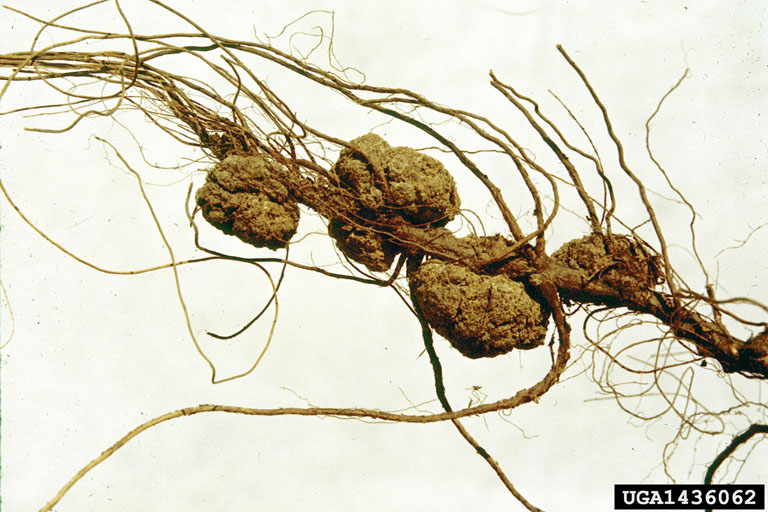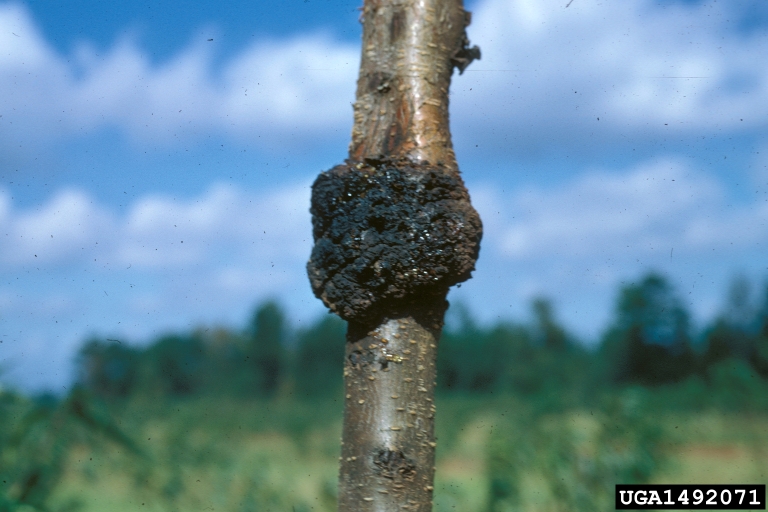 Crown Gall Disease - November 28, 2018 Jeff Schalau, Agent, Agriculture & Natural Resources University of Arizona Cooperative Extension, Yavapai County Crown gall is a bacterial disease that can impact a broad range of host plants. The crown gall disease organism is named Rhizobium radiobacter (formerly called Agrobacterium tumefaciens and Agrobacterium radiobacter). Common hosts are fruit trees, grapes, euonymus, rose, willow, and several other broadleaf trees and shrubs. It is often found in our area and gardeners should learn to recognize, remove it and, hopefully, reduce its spread. Crown gall disease symptoms are wart-like growths or galls principally on the root crown at the soil line or just below the soil surface. Galls first appear as smooth swellings and develop rapidly into large tumors with a rough, warty, or cracked appearance. Galls can also form on roots, limbs, and trunks of many woody plants. On blackberries, raspberries, and grapes, galls may also form on stems or canes. Crown gall usually does not seriously harm woody plants unless the galls occur in the root crown area when plants are young. This interrupts or slows the flow of compounds necessary for plant growth. As a result, the plants become stunted and subject to wind damage and drought stress. If galls are large, young plants can be girdled and killed. The crown gall bacteria stimulate the plant to produce actively growing, disorganized tissue which originates in the cambium (the layer between the inner bark and wood) and then swells and erupts through the bark. The surface of a crown gall is the same color as healthy bark and gall wood has the same color as normal wood. However, when cut with a knife, crown galls are softer than normal wood and lack the typical pattern of annual growth rings. Galls can be tiny and smooth on young plants, but are commonly rough and sometimes massive on mature trees. Crown gall bacteria can survive in the soil for at least 2 years in the absence of host tissue or for several years in decomposing crown gall tissue. Bacteria are released into the soil when galls are wet or when older gall tissue disintegrates. Seedlings may also be affected by the bacterium during germination; established trees and vines are infected only through fresh wounds such as those caused by growth cracks, pruning, damage by cultivation equipment, or freeze injury. Gardeners can greatly reduce problems with crown gall by obtaining planting material from a reputable nursery that uses clean propagation materials and growing media. The presence of visible galls on ornamentals in nurseries is considered sufficient for plant destruction. Galls do not appear until after the plant has been growing for one or more seasons. Whenever possible, you should examine bare-root trees and vines before purchase, and plant only high-quality nursery stock. Avoid susceptible varieties. Gardeners should plant only resistant species where crown gall has previously been a problem. Some resistant or immune species are cedar, magnolia, pine, boxwood, redbud, smoke tree, liquidambar, holly, mahonia, and pyracantha. Other practices can reduce the incidence and spread of crown gall disease. Avoid injuring trees during transplanting, and avoid injury or pruning wounds that will come into contact with soil. Existing galls may be excised by cutting into healthy wood around galls, then exposing the tissue to drying. Cut out galls only during the dry season and minimize the amount of healthy tissue into which cuts are made. Disinfect pruning and digging tools before using on healthy plants. Remove and destroy severely infected plants. Solarization during the hot dry season before planting may reduce crown gall bacteria in the soil. Do not be too aggressive on larger trees and vines as they can usually tolerate the development and presence of some crown galls. Discovery of crown gall in your orchard, vineyard, or landscape is not the end of the world, but its presence should increase your vigilance and attention to sanitation practices when working around infected plants. I have included some additional information resources and photos below. Follow the Backyard Gardener on Twitter – use the link on the BYG website. If you have other gardening questions, call the Master Gardener help line in the Camp Verde office at 928-554-8992 or e-mail us at verdevalleymg@gmail.com and be sure to include your name, address and phone number. Find past Backyard Gardener columns or provide feedback at the Backyard Gardener web site: http://cals.arizona.edu/yavapai/anr/hort/byg/. Photos  Crown galls on pecan tree (Carya illinoinensis) roots (Clemson University - USDA Cooperative Extension Slide Series).
Crown galls on pecan tree (Carya illinoinensis) roots (Clemson University - USDA Cooperative Extension Slide Series). Crown gall on peach tree (Prunus persica) stem (University of Georgia Plant Pathology).
Crown gall on peach tree (Prunus persica) stem (University of Georgia Plant Pathology). Cottonwood tree (Populus spp.) with a large crown gall at it's base (William Jacobi, Colorado State University).
Cottonwood tree (Populus spp.) with a large crown gall at it's base (William Jacobi, Colorado State University).Additional Resources Diseases of Urban Plants in Arizona University of Arizona Cooperative Extension cals.arizona.edu/extension/ornamentalhort/plantprotect/pldiseases_urban.pdf Crown Gall New Mexico State University Cooperative Extension Service aces.nmsu.edu/ces/plantclinic/documents/crown-gall-_od-1__final.pdf Crown Gall University of California Agriculture and Natural Resources ipm.ucanr.edu/PMG/r280101311.html |